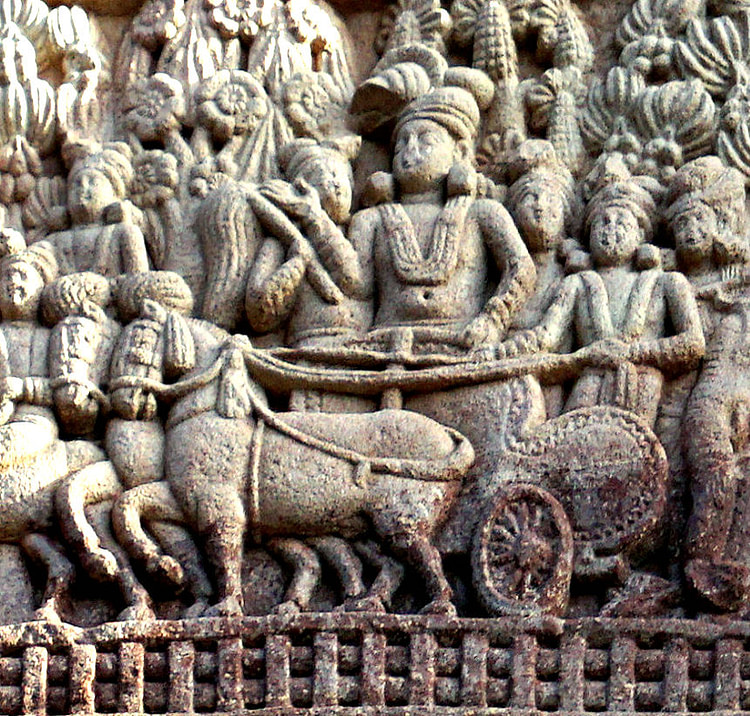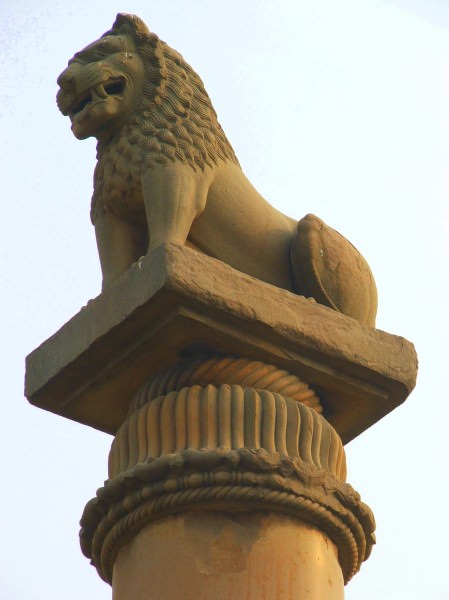The Four-Room House › Ashoka the Great » Ancient origins
Articles and Definitions › Contents
- The Four-Room House › Antique Origins
- Ashoka the Great › Who Was
Ancient civilizations › Historical and archaeological sites
The Four-Room House › Antique Origins
Definition and Origins

The four-room house, also referred to as “Israelite house” and “pillared courtyard house,” emerged in the central highlands of Canaan during the late 13th -early 12th centuries BCE in response to environmental and socio-economic needs. The four-room house would not crystallize as a design until the later 12th - 11th centuries BCE, despite its functional qualities. The typical layout of the four-room house consisted of a rectilinear plan divided into three, four, or more spaces/rooms. A larger central space was separated by one or two rows of stone pillars with an entrance that led from an exterior courtyard into the central space. Variation may exist among dwellings, as additional rooms may be added or subdivided, but the basic plan follows the description above. Within the courtyard a deep cistern was often included, as were clay or mud brick ovens and hearths for cooking. This suggests that the majority of domestic tasks were performed outdoors, especially as the side rooms were often utilized for livestock, as is suggested by the existence of cobbled floors, or as a storage space. Single, double, and possibly triple storied structures have been uncovered, which suggests that inhabitants slept and ate in the upper story, separated from the animals.
A LARGER CENTRAL SPACE WAS SEPARATED BY ONE OR TWO ROWS OF STONE PILLARS WITH AN ENTRANCE THAT LED FROM AN EXTERIOR COURTYARD INTO THE CENTRAL SPACE.
The structure would have possessed a flat roof, optimal for drying foodstuffs and additional storage, although one of the long rooms, usually the one in the center, may have been unroofed. In terms of protection, the community generally seems to have possessed a perimeter wall. Such walls are not to be confused with a defense system; on the contrary, as with the over 300 courtyard houses excavated, no defense walls were identified. Instead, the perimeter wall appears to suggest that the inhabitants drew their livestock within the walls in the evening so as to protect them from other animals or brigands, a practice that is in keeping with the agro-pastoral lifestyle of the Israelites. Following a “tree-like” shape, the four-room house allows for immediate accessibility to any room in the house from the central courtyard. The reason for this variation may reflect the egalitarian nature of the community, or perhaps concerns for purity, such as is expressed in descriptions in Leviticus 12 of an impure woman after childbirth, menstruation, etc. Although such women are not required to leave the house, it is reasonable to assume that they were expected to stay in separate rooms so as not to render the other inhabitants of the household unclean, as well.
The four-room house's popularity continued among the Israelites until the end of Iron Age II, coinciding with the Babylonian Destruction and exile.
Ashoka the Great › Who Was
Definition and Origins

Emperor Ashoka the Great (sometimes spelt Aśoka) lived from 304 to 232 BCE and was the third ruler of the Indian Mauryan Empire, the largest ever in the Indian subcontinent and one of the world's largest empires at its time. He ruled form 268 BCE to 232 BCE and became a model of kingship in the Buddhist tradition. Under Ashoka India had an estimated population of 30 million, much higher than any of the contemporary Hellenistic kingdoms. After Ashoka's death, however, the Mauryan dynasty came to an end and its empire dissolved.
ASHOKA'S RULE
In the beginning, Ashoka ruled the empire like his grandfather did, in an efficient but cruel way. He used military strength in order to expand the empire and created sadistic rules against criminals. A Chinese traveller named Xuanzang (Hsüan-tsang) who visited India for several years during the 7th century CE, reports that even during his time, about 900 years after the time of Ashoka, Hindu tradition still remembered the prison Ashoka had established in the north of the capital as “Ashoka's hell”.Ashoka ordered that prisoners should be subject to all imagined and unimagined tortures and nobody should ever leave the prison alive.
During the expansion of the Mauryan Empire, Ashoka led a war against a feudal state named Kalinga (present day Orissa) with the goal of annexing its territory, something that his grandfather had already attempted to do. The conflict took place around 261 BCE and it is considered one of the most brutal and bloodiest wars in world history. The people from Kalinga defended themselves stubbornly, keeping their honour but losing the war: Ashoka's military strength was far beyond Kalinga's.The disaster in Kalinga was supreme: with around 300,000 casualties, the city devastated and thousands of surviving men, women and children deported.
AFTER THE WAR OF KALINGA, ASHOKA CONTROLLED ALL THE INDIAN SUBCONTINENT EXCEPT FOR THE EXTREME SOUTHERN PART.
What happened after this war has been subject to numerous stories and it is not easy to make a sharp distinction between facts and fiction. What is actually supported by historical evidence is that Ashoka issued an edict expressing his regret for the suffering inflicted in Kalinga and assuring that he would renounce war and embrace the propagation of dharma. What Ashoka meant by dharma is not entirely clear: some believe that he was referring to the teachings of the Buddha and, therefore, he was expressing his conversion to Buddhism. But the word dharma, in the context of Ashoka, had also other meanings not necessarily linked to Buddhism. It is true, however, that in subsequent inscriptions Ashoka specifically mentions Buddhist sites and Buddhist texts, but what he meant by the word dharma seems to be more related to morals, social concerns and religious tolerance rather than Buddhism.
THE EDICTS OF ASHOKA
After the war of Kalinga, Ashoka controlled all the Indian subcontinent except for the extreme southern part and he could have easily controlled that remaining part as well, but he decided not to. Some versions say that Ashoka was sickened by the slaughter of the war and refused to keep on fighting. Whatever his reasons were, Ashoka stopped his expansion policy and India turned into a prosperous and peaceful place for the years to come.

Greek and Aramaic inscriptions by king Ashoka
Ashoka began to issue one of the most famous edicts in the history of government and instructed his officials to carve them on rocks and pillars, in line with the local dialects and in a very simple fashion. In the rock edicts, Ashoka talks about religious freedom and religious tolerance, he instructs his officials to help the poor and the elderly, establishes medical facilities for humans and animals, commands obedience to parents, respect for elders, generosity for all priests and ascetic orders no matter their creed, orders fruit and shade trees to be planted and also wells to be dug along the roads so travellers can benefit from them.
However attractive all this edicts might seem, the reality is that some sectors of Indian society were truly upset about them.Brahman priests saw in them a serious limitation to their ancient ceremonies involving animal sacrifices, since the taking of animal life was no longer an easy business and hunters along with fishermen were equally angry about this. Peasants were also affected by this and were upset when officials told them that “chaff must not be set on fire along with the living things in it”.Brutal or peaceful, it seems that no ruler can fully satisfy the people.
SUPPORT FOR BUDDHISM
The Buddhist tradition holds many legends about Ashoka. Some of these include stories about his conversion to Buddhism, his support of the monastic Buddhist communities, his decision to establish many Buddhist pilgrimage sites, his worship of the bodhi tree under which the Buddha attained enlightenment, his central role organizing the Third Buddhist Council, followed by the support of Buddhist missions all over the empire and even beyond as far as Greece, Egypt and Syria. The Buddhist Theravada tradition claims that a group of Buddhist missionaries sent by Emperor Ashoka introduced the Sthaviravada school (a Buddhist school no longer existent) in Sri Lanka, about 240 BCE.

Ashoka's pillar
It is not possible to know which of these claims are actual historical facts. What we do know is that Ashoka turned Buddhism into a state religion and encouraged Buddhist missionary activity. He also provided a favourable climate for the acceptance of Buddhist ideas, and generated among Buddhist monks certain expectations of support and influence on the machinery of political decision making. Prior to Ashoka Buddhism was a relatively minor tradition in India and some scholars have proposed that the impact of the Buddha in his own day was relatively limited. Archaeological evidence for Buddhism between the death of the Buddha and the time of Ashoka is scarce; after the time of Ashoka it is abundant.
A PARTICULAR STORY TELLS THAT ASHOKA BUILT 84,000 STUPAS.
Was Ashoka a true follower of the Buddhist doctrine or was he simply using Buddhism as a way of reducing social conflict by favouring a tolerant system of thought and thus make it easier to rule over a nation composed of several states that were annexed through war? Was his conversion to Buddhism truly honest or did he see Buddhism as a useful psychological tool for social cohesion? The intentions of Ashoka remain unknown and there are all types of arguments supporting both views.
ASHOKA'S LEGACY
He did with Buddhism in India what Emperor Constantine did with Christianity in Europe and what the Han dynasty did with Confucianism in China : he turned a tradition into an official state ideology and thanks to his support Buddhism ceased to be a local Indian cult and began its long transformation into a world religion. Eventually, Buddhism died out in India sometime after Ashoka's death, but it remained popular outside its native land, especially in eastern and south-eastern Asia. The world owes to Ashoka the growth of one of the world's largest spiritual traditions.
LICENSE:
Article based on information obtained from these sources:with permission from the Website Ancient History Encyclopedia
Content is available under License Creative Commons: Attribution-NonCommercial-ShareAlike 3.0 Unported. CC-BY-NC-SA License